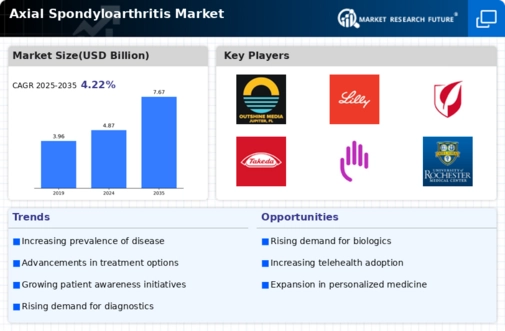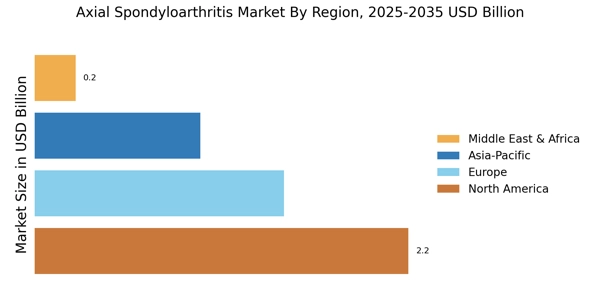Expansion of Telehealth Services
The expansion of telehealth services is emerging as a pivotal driver in the Axial Spondyloarthritis Market. The increasing adoption of telemedicine platforms allows patients to access healthcare services remotely, which is particularly beneficial for those with mobility issues associated with axial spondyloarthritis. This trend is likely to enhance patient engagement and adherence to treatment plans, as individuals can consult with healthcare providers from the comfort of their homes. Market data indicates that telehealth utilization has surged, with many patients reporting positive experiences. As telehealth continues to evolve, it may facilitate timely interventions and improve overall management of the condition, thereby contributing to the growth of the market.
Innovations in Biologic Therapies
Innovations in biologic therapies represent a significant advancement in the Axial Spondyloarthritis Market. Biologics, which target specific components of the immune system, have shown promising results in managing symptoms and slowing disease progression. The introduction of new biologic agents, such as IL-17 inhibitors, has expanded treatment options for patients. Market data indicates that the biologics segment is expected to witness substantial growth, potentially reaching a valuation of several billion dollars in the coming years. This growth is driven by the increasing recognition of the efficacy of biologics in improving quality of life for patients. As more treatment options become available, healthcare providers are likely to adopt these therapies, further propelling the market forward.
Growing Demand for Personalized Medicine
The growing demand for personalized medicine is reshaping the Axial Spondyloarthritis Market. Patients are increasingly seeking tailored treatment approaches that consider their unique genetic and phenotypic characteristics. This shift towards personalized medicine is prompting healthcare providers to adopt more precise diagnostic tools and treatment strategies. Market data suggests that personalized therapies may lead to improved patient outcomes and higher satisfaction rates. As the understanding of the disease's underlying mechanisms advances, the development of targeted therapies is likely to gain momentum. This trend could result in a more effective management of axial spondyloarthritis, ultimately driving market growth as patients and providers alike embrace individualized care.
Rising Investment in Research and Development
Rising investment in research and development is a crucial driver for the Axial Spondyloarthritis Market. Pharmaceutical companies are increasingly allocating resources to develop novel therapies and improve existing treatment modalities. This trend is evidenced by the growing number of clinical trials focused on axial spondyloarthritis, with many new compounds entering various stages of development. The commitment to R&D is expected to yield innovative solutions that address unmet medical needs, potentially transforming the treatment landscape. Furthermore, collaborations between academic institutions and industry players are likely to enhance the pace of discovery and development. As new therapies emerge, they may significantly impact patient management and market dynamics.
Increasing Prevalence of Axial Spondyloarthritis
The rising prevalence of axial spondyloarthritis is a notable driver in the Axial Spondyloarthritis Market. Recent estimates suggest that the condition affects approximately 0.5% to 1% of the population, with a higher incidence observed in certain demographics. This increasing prevalence is likely to lead to a greater demand for diagnostic and therapeutic options, thereby expanding the market. As awareness grows, more individuals are being diagnosed, which could further contribute to the market's growth. The need for effective management strategies and treatment options is becoming increasingly critical, as untreated axial spondyloarthritis can lead to significant morbidity. Consequently, healthcare providers are focusing on early diagnosis and intervention, which may enhance patient outcomes and drive market expansion.


















Leave a Comment